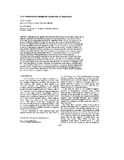| dc.contributor.author | King, J.G. | |
| dc.contributor.author | Williams, W. | |
| dc.date.accessioned | 2009-07-03T14:05:49Z | |
| dc.date.available | 2009-07-03T14:05:49Z | |
| dc.date.issued | 200 | |
| dc.identifier.citation | King, J.G. et al (2000) Low-temperature magnetic properties of magnetite, Journal of Geophysical Research, vol. 105, no. B7. pp.16,427-16,436. | en_US |
| dc.identifier.issn | 0148-0227 | |
| dc.identifier.uri | http://hdl.handle.net/10311/347 | |
| dc.description.abstract | Although several studies have recommended removal of secondary components of magnetic remanence by zero-field cycling from room temperature to a temperature much lower than the low temperature transition for magnetite (about 120 K), the method has not become a standard routine technique. This is partly due to the poor understanding of the behavior of magnetite particles at the low-temperature transition zone. Previous experiments by other researchers have used magnetite powders. In such powders it is always possible to attribute any discrepancy between the results observed and theory to possible existence of magnetostatic interaction effects or existence of elongated particles in samples presumed to contain only equant particles. Such factors need to be eliminated in order to have a better understanding of the low temperature behavior of magnetite particles. Low-temperature magnetic properties of lithographically produced arrays of both interacting and noninteracting cubic magnetite particles as well as those from powder particles have been measured as part of this study. A gradual increase in the amount of saturation isothermal remanent magnetization (SIRM) lost at the Verwey transition Tv with increasing particle size in the pseudo-single-domain size range has been observed. This behavior is consistent with the vortex state domain structure. The grain size dependence of the amount of SIRM lost at Tv is most probably what previous researchers reported as a magnetic memory particle-size-dependent trend. Magnetic memory measured during the cooling and warming process is shown to be a stress-related phenomenon. Such measurements could be useful in assessing the nature of stress in a magnetite sample. | en_US |
| dc.language.iso | en | en_US |
| dc.publisher | American Geophysical Union. http://www.agu.org/journals/jd/ | en_US |
| dc.subject | Theory | en_US |
| dc.subject | Particles | en_US |
| dc.subject | Low temperature | en_US |
| dc.subject | Magnetic properties | en_US |
| dc.subject | Magnetite | en_US |
| dc.subject | Curie point | en_US |
| dc.subject | Magnetic susceptibility | en_US |
| dc.subject | Stoichiometry | en_US |
| dc.subject | SEM data | en_US |
| dc.subject | Thermal demagnetization | en_US |
| dc.subject | Stress | en_US |
| dc.subject | Spinel | en_US |
| dc.subject | Oxides | en_US |
| dc.title | Low-temperature magnetic properties of magnetite | en_US |
| dc.type | Published Article | en_US |

